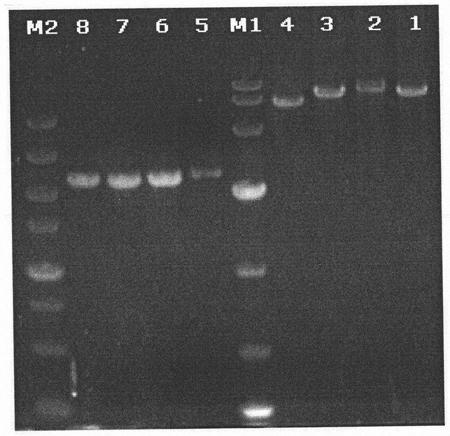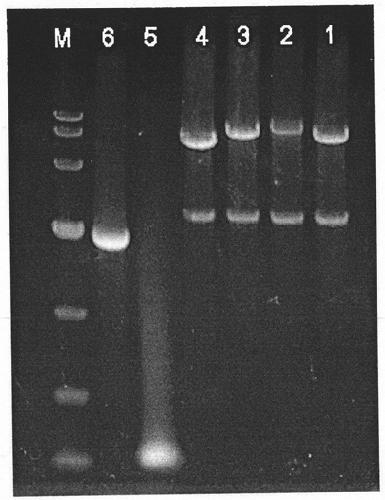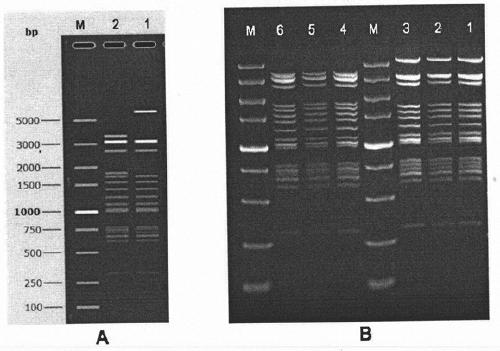Method for constructing coronavirus infectious clone and application thereof
A technology for infectious cloning and coronavirus, which is applied in the direction of viruses, antiviral agents, viruses/phages, etc., can solve the problems of unstable preservation of coronavirus cDNA, inability to obtain a complete genome, and low efficiency of enzymatic cleavage and connection. Integrity, high rescue efficiency, avoiding unstable effects
- Summary
- Abstract
- Description
- Claims
- Application Information
AI Technical Summary
Problems solved by technology
Method used
Image
Examples
Embodiment 1
[0063] Construction of infectious clone of avian infectious bronchitis virus IBV-H120
[0064] 1) Primers and gene synthesis
[0065] According to the H120 infectious clone design sequence and rescue strategy, design linear vector amplification primers, point mutation primers, auxiliary plasmid construction primers and identification and detection primers. The primers and genes were synthesized by BGI (Table 1).
[0066] Table 1 Primers used in this study
[0067] Table 3.1 Nucleotide sequences of oligos used in this work
[0068]
[0069]
[0070]
[0071]
[0072] Note: The bolded sequence in italics is the T7 promoter, and the underlined sequence is the restriction endonuclease recognition site
[0073] 2) RNA extraction of avian infectious bronchitis virus vaccine strain H120
[0074] Avian infectious bronchitis virus vaccine strain H120 virulent allantoic cavity was inoculated with 9-day-old SPF chicken embryos, and the allantoic fluid of the remaining chicken embryos was harvested ...
experiment example 1
[0102] Rescue virus detection
[0103] 1) RT-PCR detection
[0104] Take 200μL of rH120 F5 strain virus liquid and extract viral RNA according to the instructions of Axyprep Body Fluid Virus DNA / RNA Small Extraction Kit. The extracted RNA is dissolved in 40μL RNase-free TE buffer, and 10μL RNA is taken according to Recombinant DNase I (RNase-free) (Takara) Instructions to remove DNA. Using the above RNA as a template, the primers IBV-S1-F / R, IBV-MF / R and H120-3ab-F / R in Table 3.1 are expanded according to the instructions of PrimeScript OneStep RT-PCR Kit Ver.2 Increase S1, M and 3ab genes. RT-PCR products were observed by 1% agarose gel electrophoresis Figure 5 , And sent to Huada Gene Company for sequencing. See the sequencing results Image 6 .
[0105] 2) Western blotting detection of M protein
[0106] Inoculate the rH120 F5 and female H120 virus liquids into the cell culture six-well plate monolayer CK cells, adsorb at 37°C for 2h, then change to 2% serum DMEM medium, and pl...
experiment example 2
[0112] Rescue the biological characteristics of the virus
[0113] 1) Determination of rH120 virus growth
[0114] Dilute the rH120 F5 virus liquid and the mother virus H120 virus with normal saline, and inoculate 30 10-day-old SPF chicken embryos through the allantoic cavity. 2 EID50 / embryo. The virus allantoic fluid of 5 chicken embryos was harvested at 6h, 12h, 24h, 36h and 48h respectively after inoculation, mixed and aliquoted and stored at -80℃.
[0115] ( Picture 9 ) The results showed that the proliferation trend of rH120 F5 virus was basically the same as that of the female parent strain H120. The overall titer of rH120 F5 was slightly lower than that of the female parent strain H120, and the difference in virus titers was not significant (p>0.05). The strain H120 is basically the same. It shows that rH120 F5, like the female parent strain H120, is highly adapted to chicken embryos.
PUM
 Login to View More
Login to View More Abstract
Description
Claims
Application Information
 Login to View More
Login to View More - R&D
- Intellectual Property
- Life Sciences
- Materials
- Tech Scout
- Unparalleled Data Quality
- Higher Quality Content
- 60% Fewer Hallucinations
Browse by: Latest US Patents, China's latest patents, Technical Efficacy Thesaurus, Application Domain, Technology Topic, Popular Technical Reports.
© 2025 PatSnap. All rights reserved.Legal|Privacy policy|Modern Slavery Act Transparency Statement|Sitemap|About US| Contact US: help@patsnap.com



